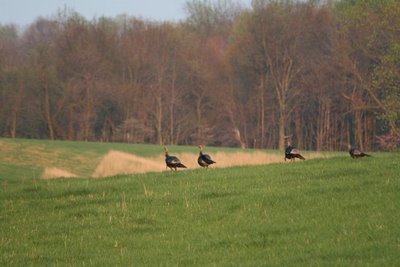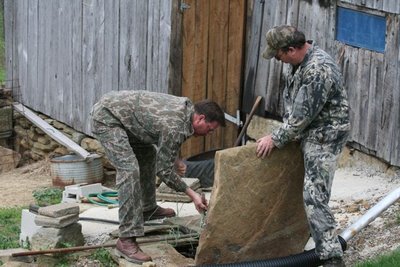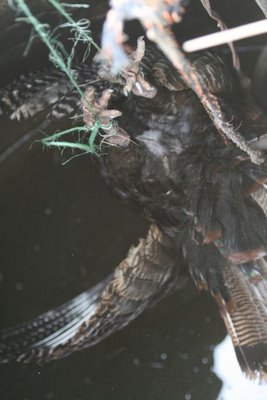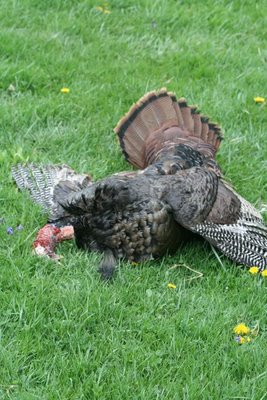Turkey Days II
Yesterday I left you hanging. Well, at least those of you who didn't immediately scramble around, chimplike, to find the answer. Why should the base of the beard of a turkey gobbler be richly supplied with nerve endings?
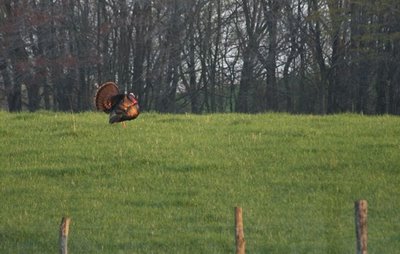 Ooh, I love this picture, a perfect bronze gobbler bathed in afternoon light right by our mailbox!
Ooh, I love this picture, a perfect bronze gobbler bathed in afternoon light right by our mailbox!The answer lies in the mating behavior of wild turkeys. When the gobbler is excited, he’s puffed up to three times his normal apparent volume, every feather on end until he’s practically spherical. Like anyone who’s climbed on the scale with a bit (or a lot) of a pot belly, it can be hard to see what lies below; you either have to suck that belly in or crane your neck. In mating, the hen turkey lies flat on the ground, her head sticking straight up, wings out to the side. The tom climbs aboard and treads her shoulders with his feet. As it happens, his beard brushes the top of her head. (We've seen this twice in our own backyard!) Maybe that’s nice for the hen, but it’s essential for the tom. Because he can’t see over his own massive bulk, it’s how he can tell he’s in the right position to mate successfully. He keeps his beard in contact with her head throughout the treading and copulation. And so the beard seems to have a function besides the decorative, and those nerve endings make all kinds of sense in light of their behavior and the mechanics of copulation.
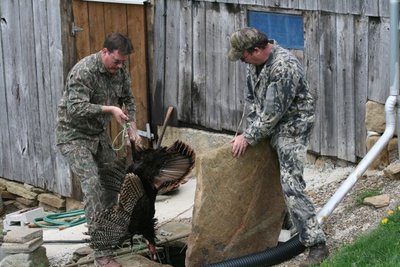
When the Warrens tell me some bit of natural history lore, I listen, because they’ve gained their knowledge through direct experience with wild things. When I tell them something, they listen right back. It’s good.
Jay lowers the turkey back into the cistern, a natural refrigerator.
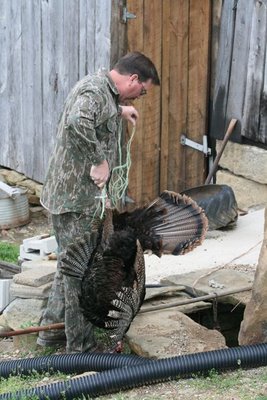
I know that there are many who will look at these pictures and be repulsed by the sight of a wild turkey, sprawled out, turned into food. But the more I think about how and what most of us carnivores eat, the more sense it makes to me to walk out on your own land and with a couple of shots, fell a bird that will feed you for several days. Surely it is more in harmony with nature than eating a steak from a cow that was fed grain—a diet that doesn’t agree with it, a diet that makes it gassy and bloated-- in a Montana stockyard, slaughtered and trucked halfway across the country. I felt only a twinge of sadness on seeing the bird, knowing that there are a lot of turkeys around, knowing that it only takes one dominant gobbler to father many broods of poults, knowing a little about their impact on the understory vegetation and on the vanishing ruffed grouse in our area.
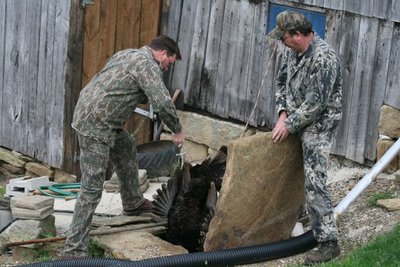 I have to tell you, the best book on wild turkeys I have ever read, or ever expect to read, is Illumination in the Flatwoods: A Season with the Wild Turkey by Florida naturalist/artist Joe Hutto. He raised a brood of 14 from a clutch of orphaned, pipping eggs and walked with them in the woods to learn their ways and protect them, and return them gently to the wild. If you read nothing else, You Must Read This.
I have to tell you, the best book on wild turkeys I have ever read, or ever expect to read, is Illumination in the Flatwoods: A Season with the Wild Turkey by Florida naturalist/artist Joe Hutto. He raised a brood of 14 from a clutch of orphaned, pipping eggs and walked with them in the woods to learn their ways and protect them, and return them gently to the wild. If you read nothing else, You Must Read This.After the turkey viewing, we sat on the hill, enjoying the warm sun and soft breeze. Chet Baker cried until I let him out of the car and he went from Jay to Jeff and back again, meeting and greeting, snuffling, leaping and licking. They worried that he’d run away; I knew he wouldn’t. For a Boston terrier, home is where the heart is, where the people are. They’re such happy little dogs, so loving and sociable. The Warrens are nuts about him. Jay always sings "My Funny Valentine" to him.
Funny Valentine he is. His mouth is a little weak. But his figure is completely Greek.
When he’d get off on the trail of a rabbit or vole and begin to stray, a quiet, “Hyah, Bake!” would turn him on a dime and bring him smiling back to us.
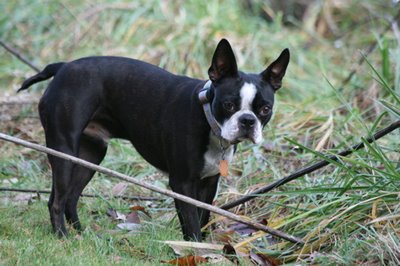
I always dreamed of having a dog like that, a dog who listens, a dog who cares. A dog who responds not to shouted commands but to normal quiet tones; to English words and whole- sentence suggestions. It’s a two-way dance. To have a quiet dog like that, you must be quiet yourself.
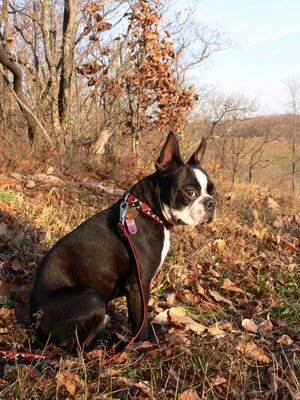 so take the darn thing off already. Ah, but Bake, there are cattle in the pasture below. Sometimes a word is not enough.
so take the darn thing off already. Ah, but Bake, there are cattle in the pasture below. Sometimes a word is not enough.I don't know how a discussion of turkey beards turned into a Baker fix. It's been awhile, and he's just such a good doggeh. I thought you wouldn't mind.
Tomorrow morning bright and early, the rest of us head to Fayetteville, WV, to join Bill of the Birds in entertaining the happy festivalgoers to the New River Birding and Nature Festival who want to see Swainson's warblers, golden, cerulean and blue-winged warblers, and a plethora of other fabulous Neotropical migrants. I'll be speaking at Opossum Creek Resort Thursday night, a talk on the biology and natural history of migrant warblers. Bill and I, along with our fabulous faithful bassist Clay, play music for the Friday night gathering, and we're leading field trips Friday and Saturday mornings. It's festival time. But I'm happy because we'll all be together, even that good lil' doggeh, the Mayor of Opossum Creek. He will not be on the lead. He will be going cabin to cabin, meeting and greeting, bumming hamburgers.
Labels: Chet Baker, function of turkey beard, Illumination in the Flatwoods, Joe Hutto, wild turkey

